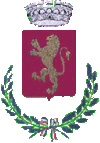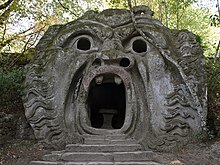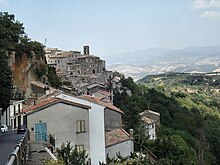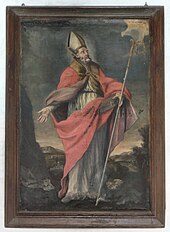Bomarzo
| Bomarzo | ||
|---|---|---|

|
|
|
| Country | Italy | |
| region | Lazio | |
| province | Viterbo (VT) | |
| Coordinates | 42 ° 29 ' N , 12 ° 15' E | |
| height | 263 m slm | |
| surface | 39.89 km² | |
| Residents | 1,743 (Dec. 31, 2019) | |
| Population density | 44 inhabitants / km² | |
| Post Code | 01020 | |
| prefix | 0761 | |
| ISTAT number | 056009 | |
| Popular name | Bomarzesi | |
| Patron saint | Anselm from Polymartium | |
| Website | Bomarzesi | |
Bomarzo is an Italian commune with 1743 inhabitants (as of December 31, 2019) in the province of Viterbo , Lazio region . It is located 84 km north of Rome and 19 km northeast of Viterbo .
Geography and landscape
Bomarzo lies on a tuff hill at the foothills of the Monti Cimini ; north of this mountain range the land slopes down to the upper reaches of the Tiber . From the compact peperin plateaus of volcanic origin, loosened blocks were repeatedly detached by erosion, which were further used as building material. Clay collected below the plateaus in the plains .
The landscape around Bomarzo has been protected as Riserva Monte Casoli di Bomarzo on an area of 285 hectares since 1999 . Woods and pastures as well as areas around Monte Casoli , which was also an archaeological excavation site, about 2.5 km outside of Bomarzo, are recorded.
Bomarzo bears the Bandiera Arancione , a quality seal in the field of tourism and the environment from the TCI .
history
Excavations of necropolises in the middle of the 19th century have shown that there was an Etruscan precursor settlement in the place of the present-day city . Whether it was the Planum Meonianum identified by the Dominican Annio da Viterbo around 1500 could not ultimately be proven. Most of the archaeological sites around Monte Casoli have overgrown again in the 21st century.
The name Polymartium is mentioned for the first time in the Historia Langobardorum by Paulus Diaconus . The name etymology (City of Mars ) suggests that there might have been a Roman city; the excavation work, however, did not unearth any concrete building fabric.
Polymartium was the seat of a bishopric by the 5th century at the latest. It is certain that the patron saint Anselm was not the first bishop and that he was martyred under the Gothic king Totila . Lambertus Episcopus Polymartiensis is documented as the last bishop of the city in 1015. The titular bishopric Polymartium goes back to the bishopric .

Since the 8th century Bomarzo belonged as the entire present-day province of Viterbo Papal States . Real control was exercised by the local feudal lords. In the case of Bomarzo, it was the Orsini ; among them Vicino Orsini has become the most formative personality for the city. Under his aegis in the 16th century, the aristocratic palace ( Palazzo Orsini ) begun by his father was completed and the peculiar mannerist park of the monsters laid out outside the city, which he himself called a "sacred forest" ( Sacro Bosco ). Vicino Orsini was married to Giulia Farnese , daughter of Galeazzo Farnese (Duke of Latera ); not to be confused with her grandmother (maternal) Giulia Farnese , the mistress of Alexander VI. In the case of Bomarzo, the transition from feudal rule to the papal central state, which in large parts of Lazio was accompanied by armed conflict, took place through a marriage policy.
The strengthened papal central state installed cardinals as regents; Ippolito Lante , who resided in the Villa Lante in Bagnaia , but also temporarily in the Palazzo Orsini in Bomarzo, is characteristic of this period.
Bomarzo has been part of the Italian nation-state since 1870, like the entire former papal state.
Cityscape and landmarks
The old town is a compact medieval Borgo with small streets leading up to the church and the Orsini Palace. Numerous houses are built from the locally occurring peperin rock.
- The Cathedral of Santa Maria Assunta ( Assumption of the Virgin Mary ) is a Romanesque building on the foundation walls of the early Christian predecessor of Anselm's time, which is also buried in the church. Vicino Orsini had the Renaissance facade added in the 16th century.
- The Palazzo Orsini was also built in the 16th century on the remains of a medieval castle. Baldassare Peruzzi , architect and painter in Siena and Rome, planned the two-wing complex with inner courtyard, loggia and staircase, which has since been changed several times on behalf of Orsini. In the 17th century, Cardinal Ippolito Lante furnished the large drawing room on the first floor with the theme of Allegory of War and Peace by Lorenzo Berrettini from Cortona . The building has been used as a municipal administration since the Second World War; the loggia is the council chamber, decorated with frescoes by Antonangelo Bonifazi (Viterbo, 17th century).

About two kilometers outside the city there is a garden that was laid out for Vicino Orsini between 1552 and 1585. It is called Parco dei Mostri (Park of the Monsters) because of its sculpture program and is known as Sacro Bosco (Sacred Forest). Landscape and architecture form a strange area of confusion, a bizarre staging of grotesque figures, fantastic buildings and enigmatic sayings. An irregular path leads from a square orchard to a stream valley. The path is lined with a bizarre, cruel sculpture program that puzzles visitors and can arouse amazement. The pictorial program, which seems to have been preserved incompletely, is still the subject of speculative interpretations, although it has been largely deciphered. It is a literary concept referring to Ludovico Ariosto and his poem Orlando furioso ( The mad Roland ). Vicino Orsini was an admirer of Ariostus and Petrarch .
Economy and Social
Bomarzo is dominated by agriculture. There are local cooperatives for wine and olive oil, hazelnuts and honey, some of which are organically grown.
The amusement park with picnic areas on the edge of the Sacro Bosco makes Bomarzo an attractive destination for families with children in the warm season, especially on the weekends. International guests also visit the place and its surroundings knowing the Park of the Monsters . However, the limited infrastructural resources are not geared towards package tourism. There is a hotel, a few bed and breakfasts and agrotourism facilities, restaurants, trattorias and bars.
Some artisans maintain their workshops on site (blacksmiths, wood carvers, copper engravers, lace makers).
Patronage festival on 24./25. April
Every year a two-day city festival is held in honor of Saint Anselm von Bomarzo . The centerpiece is a horse race based on the Palio principle, in which the five medieval contrades Il Dentro , Borgo , Poggio , Croci and Madonna del Piano compete against each other. The Palio is first documented around 1600.
At the accompanying fair ( Sagra del Biscotto ), the so-called biscotto di Sant'Anselmo (formerly pane di Sant'Anselmo ) is publicly baked and sold, a 1 kg ring-shaped yeast pastry, seasoned with anise, which the bishop, according to legend, gave to the Poor and is said to have distributed to the pilgrims on their way to Rome. This festival has only existed since 1973, organized by the local organization Pro Loco .
literature
- Horst Bredekamp , Wolfram Janzer : Vicino Orsini and the sacred forest of Bomarzo. A prince as artist and anarchist (= Green Series 7). 2nd revised edition. Werner, Worms 1991, ISBN 3-88462-061-4 .
- Gunda Hinrichs: The sacred forest of Bomarzo. An enigmatic Italian Renaissance garden and Freud's dream interpretation as a method of its interpretation. With photographs by Werner Holtmann. Gebr. Mann Verlag, Berlin 1996, ISBN 3-7861-1283-5 .
- Elli Mosayebi, Christian Mueller Inderbitzin: Bomarzo, observations based on a new map (= Institute for Landscape Architecture. Pamphlet. 3: Theory). Institute for Landscape Architecture ETH, Zurich 2005, ISBN 3-906441-06-7 (also: Zurich, ETH, diploma thesis, 2003).
- Bruno J. Richtsfeld: The "holy forest" of Bomarzo and its "hell mouth". In: Werner Engelmann, Bruno J. Richtsfeld (Ed.): Metamorphoses. A comparison of works by Werner Engelmann and ethnographic objects. State Museum for Ethnology, Munich 1989, ISBN 3-927270-01-6 , pp. 18–36.
- Silo ( Mario Rodríguez Cobos ): Obras Completas. Volume 2: El bosque de Bomarzo. Plaza y Valdes, México 2002, ISBN 970-722-056-2 .
- Inka-Gabriela Schmidt : Angel Sorrow. Rhede 2012, ISBN 978-3-94369-716-2 .
- Renate Vergeiner : Bomarzo. A garden against God and the world . Birkhäuser, Basel / Berlin 2017, ISBN 978-3-0356-1203-5 .
Web links
Individual evidence
- ↑ Statistiche demografiche ISTAT. Monthly population statistics of the Istituto Nazionale di Statistica , as of December 31 of 2019.




